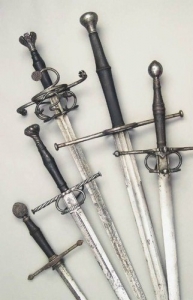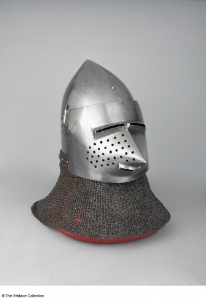No products in the cart.
The Evolution Of the Medieval Sword In the 13th – 15th Centuries
 Sword design in the late medieval period evolved in direct response to rapid growth of the armor of the late medieval era. Hence, the understanding as to how, and why, medieval swords evolved as they did, is intertwined with an understanding of the changes in armor production during the later part of the Middle Ages.
Sword design in the late medieval period evolved in direct response to rapid growth of the armor of the late medieval era. Hence, the understanding as to how, and why, medieval swords evolved as they did, is intertwined with an understanding of the changes in armor production during the later part of the Middle Ages.
As the arsenal of medieval weapons improved, so did the armor. The evolution of armor came as a direct response to the ever improving blade geometry of the late medieval sword. Compounded to this threat, was the ever growing arsenal of armor piercing weapons. As armor improved, the design and function of medieval weapons, in turn, improved and developed, making it easier to penetrate the complex armor of the late 15th century. This dual relationship, between both sword design and armor construction is referred to by some historians as the “arms race” of the late medieval period.
The high Middle Ages is the period between the early 13th and the 15th century. During  this 300 year span, armor changed more dramatically and more rapidly than it had in the previous millennium. Prior to the 13th century, the primary armor was chain mail; a suit made of small interlocking rings of steel. Providing exceptional movement and a well distributed weight pattern.
this 300 year span, armor changed more dramatically and more rapidly than it had in the previous millennium. Prior to the 13th century, the primary armor was chain mail; a suit made of small interlocking rings of steel. Providing exceptional movement and a well distributed weight pattern.
Chain mail was quite effective in countering slashes and cuts afflicted by the swords leading up to the zenith of the 13th century, (particularly of type X-XIV). The tightly woven four-in-one and riveted mail armor produced a form of skin strengthened not only by the inherent strength of the alloyed rings, but also by its natural ability to disperse pressure inflicted by incoming blows. This ability however was severely challenged by the changing blade geometry, or shape, of the swords of the late 13th century. Wider at the base and with a deep seeted taper, the swords emerging during the 13th century were not only designed to break through the link armor of the period, but to pierce through it.
Crossbows, halberds, war hammers and lances were also becoming increasingly popular weapons during the 13th century. This emergence of bludgeoning weapons curtailed the effectiveness of the Chain mail and, in response, the medieval world witnessed the rise of composite armors during the mid 13th century. With this, the onset of the English longbow during the 13th and 14th century is not to be overlooked. The longbow punctured through mail armor from a hundred yards. This led to increased usage of steel plates. Composite armors combined both chain and steel plates to the Medieval Knight’s or soldier’s armor.
Initially, the joints of composite armors were left uncovered to alloy freedom of movement. These unprotected joint however proved to be a vulnerability. Longer and pointed tapered blades began to emerge, extending the soldier’s reach, permitting him to pierce in narrow openings, under the gorget, armpits, joints, and through the visors. The grip of the medieval swords were also extended. The introduction of hand-and-a-half swords during the late 13th C. and two handed swords during the 14th C. enabled strikes of greater force. Slashing weapons largely fell out of style. Hence, the arms race escalated and metal plates were added to protect the elbows – couters – and knees, or poleyns. By the end of the 14th C. the breast plate of the Medieval armor evolved from one piece to the two parts construction, lower overlapping the upper, and contrived, by means of straps or sliding rivet, to offer more flexibility.
 To improve the cutting ability and quality, the sword makers of the 14th century began using various alloys, effectively strengthing the alloy and thus making the edge and tip more efficient. This blend of various alloys and diverse tempering rendered the core of the blade softer and therefore more flexible while the outer (iron) layer was infused with of carbon to make it a harder alloy. This harder metal allowed the edges and the tip of the blade remain sharp for extended use while giving it the ability to absord shock – and not break, while giving it the strength to thrust through the thicker, tempered plated armors emerging at the end of the 14th century.
To improve the cutting ability and quality, the sword makers of the 14th century began using various alloys, effectively strengthing the alloy and thus making the edge and tip more efficient. This blend of various alloys and diverse tempering rendered the core of the blade softer and therefore more flexible while the outer (iron) layer was infused with of carbon to make it a harder alloy. This harder metal allowed the edges and the tip of the blade remain sharp for extended use while giving it the ability to absord shock – and not break, while giving it the strength to thrust through the thicker, tempered plated armors emerging at the end of the 14th century.
The Swords of the 14th & 15th Century
The longsword, also known as the bastardsword, was the iconic medieval sword used during the late medieval period. It is classified by Ewart Oakeshott as a Type XIIIa sword. It differs from earlier swords, mostly by its longer hilt and narrow tappered blade. While pre 14th C. sword blades averaged at 36″, the bastard swords, or longswords, averaged at 42″. The longsword also became considerably thicker in cross-section, thinner in width, and more acutely pointed.
 By the first half of the 15th century, the medieval world witnessed the rise of the full plated armor. This culmination of the individual metal plates evolved into the full plated armor of the gothic period. It had pauldrons (shoulder) and elbow guards (couters) and gauntlets formed of braod overlapping plates. This is the era when we find the strongest sharpest two-handed medieval swords as well. By the end of the 15th Century however, the introduction of gunpowder from the east and the increased advantage of firearm, proved the full plated armor too cumbersome for the protection it offered. Ease and manufacturing cost of guns led to the decline of body armor. By the Thirty Years War, in 1648, the full plated armor had become obsolete.
By the first half of the 15th century, the medieval world witnessed the rise of the full plated armor. This culmination of the individual metal plates evolved into the full plated armor of the gothic period. It had pauldrons (shoulder) and elbow guards (couters) and gauntlets formed of braod overlapping plates. This is the era when we find the strongest sharpest two-handed medieval swords as well. By the end of the 15th Century however, the introduction of gunpowder from the east and the increased advantage of firearm, proved the full plated armor too cumbersome for the protection it offered. Ease and manufacturing cost of guns led to the decline of body armor. By the Thirty Years War, in 1648, the full plated armor had become obsolete.


